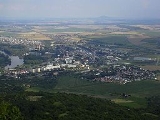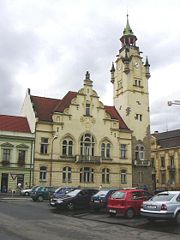
Lovosice
Encyclopedia
Lovosice (ˈlovosɪtsɛ; ) is a small town in northern Bohemia
, the western part of the Czech Republic
.
Geographic coordinates of Lovosice are: latitude
50° 51' and
longitude
: 14° 05'.
Lovosice is located on the left bank of the Labe
(Elbe
) River, at the northern border of the Labe lowlands and at the southern foot of Bohemian Highlands (České Středohoří). The closest mountain is Lovoš. The capital Prague
is about 60 km towards south.
Lovosice belongs to Ústí nad Labem Region
, Litoměřice
district.
Lovosice is a surprisingly long and narrow town. This shape is the origin of the common Czech saying "as long as Lovosice".
Due to its strategic location, Lovosice is a significant transport
junction. Besides a cargo port on the Labe River, the town has a great connection to Prague
and Germany
via the D8 motorway and high speed railway Prague
- Ústí nad Labem
- Dresden
.
The town is quite industrial with a long tradition of chemical
and food-processing
factories.

. Some evidence indicates that the first Czechs lived right here.
The first mention of Lovosice is from April 12, 1143. Prince Vladislav II gave this small village to the Strahov monastery
. Emperor Rudolf II promoted the village to the status of town on July 4, 1600.
Lovosice was 1756 the site of a major battle between Prussia
and the Austrian empire
, at the Battle of Lobositz
.
During World War II
, due to the Munich Agreement
, Lovosice fell within a German occupation zone, commonly called Sudetenland
. Only 600 Czechs stayed in the town at that time. After the war, the German population was expulsed
as a result of the Beneš decrees
.
Bohemia
Bohemia is a historical region in central Europe, occupying the western two-thirds of the traditional Czech Lands. It is located in the contemporary Czech Republic with its capital in Prague...
, the western part of the Czech Republic
Czech Republic
The Czech Republic is a landlocked country in Central Europe. The country is bordered by Poland to the northeast, Slovakia to the east, Austria to the south, and Germany to the west and northwest....
.
Geographic coordinates of Lovosice are: latitude
Latitude
In geography, the latitude of a location on the Earth is the angular distance of that location south or north of the Equator. The latitude is an angle, and is usually measured in degrees . The equator has a latitude of 0°, the North pole has a latitude of 90° north , and the South pole has a...
50° 51' and
longitude
Longitude
Longitude is a geographic coordinate that specifies the east-west position of a point on the Earth's surface. It is an angular measurement, usually expressed in degrees, minutes and seconds, and denoted by the Greek letter lambda ....
: 14° 05'.
Lovosice is located on the left bank of the Labe
Labe
Lab can refer to:* Elbe, a river in Central Europe - Labe in Czech* Labé, the main city of the Fouta Djallon region of Guinea...
(Elbe
Elbe
The Elbe is one of the major rivers of Central Europe. It rises in the Krkonoše Mountains of the northwestern Czech Republic before traversing much of Bohemia , then Germany and flowing into the North Sea at Cuxhaven, 110 km northwest of Hamburg...
) River, at the northern border of the Labe lowlands and at the southern foot of Bohemian Highlands (České Středohoří). The closest mountain is Lovoš. The capital Prague
Prague
Prague is the capital and largest city of the Czech Republic. Situated in the north-west of the country on the Vltava river, the city is home to about 1.3 million people, while its metropolitan area is estimated to have a population of over 2.3 million...
is about 60 km towards south.
Lovosice belongs to Ústí nad Labem Region
Ústí nad Labem Region
Ústí nad Labem Region is an administrative unit of the Czech Republic, located in the north-western part of its historical region of Bohemia...
, Litoměřice
Litomerice
Litoměřice is a town at the junction of the rivers Elbe and Ohře in the north part of the Czech Republic, approximately 64 km northwest of Prague....
district.
Lovosice is a surprisingly long and narrow town. This shape is the origin of the common Czech saying "as long as Lovosice".
Due to its strategic location, Lovosice is a significant transport
Transport
Transport or transportation is the movement of people, cattle, animals and goods from one location to another. Modes of transport include air, rail, road, water, cable, pipeline, and space. The field can be divided into infrastructure, vehicles, and operations...
junction. Besides a cargo port on the Labe River, the town has a great connection to Prague
Prague
Prague is the capital and largest city of the Czech Republic. Situated in the north-west of the country on the Vltava river, the city is home to about 1.3 million people, while its metropolitan area is estimated to have a population of over 2.3 million...
and Germany
Germany
Germany , officially the Federal Republic of Germany , is a federal parliamentary republic in Europe. The country consists of 16 states while the capital and largest city is Berlin. Germany covers an area of 357,021 km2 and has a largely temperate seasonal climate...
via the D8 motorway and high speed railway Prague
Prague
Prague is the capital and largest city of the Czech Republic. Situated in the north-west of the country on the Vltava river, the city is home to about 1.3 million people, while its metropolitan area is estimated to have a population of over 2.3 million...
- Ústí nad Labem
Ústí nad Labem
Ústí nad Labem is a city of the Czech Republic, in the Ústí nad Labem Region. The city is the 7th-most populous in the country.Ústí is situated in a mountainous district at the confluence of the Bílina and the Elbe Rivers, and, besides being an active river port, is an important railway junction...
- Dresden
Dresden
Dresden is the capital city of the Free State of Saxony in Germany. It is situated in a valley on the River Elbe, near the Czech border. The Dresden conurbation is part of the Saxon Triangle metropolitan area....
.
The town is quite industrial with a long tradition of chemical
Chemical industry
The chemical industry comprises the companies that produce industrial chemicals. Central to the modern world economy, it converts raw materials into more than 70,000 different products.-Products:...
and food-processing
Food
Food is any substance consumed to provide nutritional support for the body. It is usually of plant or animal origin, and contains essential nutrients, such as carbohydrates, fats, proteins, vitamins, or minerals...
factories.

History of Lovosice
The region of Lovosice was inhabited already in the Bronze AgeBronze Age
The Bronze Age is a period characterized by the use of copper and its alloy bronze as the chief hard materials in the manufacture of some implements and weapons. Chronologically, it stands between the Stone Age and Iron Age...
. Some evidence indicates that the first Czechs lived right here.
The first mention of Lovosice is from April 12, 1143. Prince Vladislav II gave this small village to the Strahov monastery
Strahov Monastery
Strahov Monastery is a Premonstratensian abbey founded in 1149 by Bishop Jindřich Zdík, Bishop John of Prague, and Prince Vladislav II. It is located in Strahov, Prague, Czech Republic.-The founding of a monastery:...
. Emperor Rudolf II promoted the village to the status of town on July 4, 1600.
Lovosice was 1756 the site of a major battle between Prussia
Prussia
Prussia was a German kingdom and historic state originating out of the Duchy of Prussia and the Margraviate of Brandenburg. For centuries, the House of Hohenzollern ruled Prussia, successfully expanding its size by way of an unusually well-organized and effective army. Prussia shaped the history...
and the Austrian empire
Habsburg Monarchy
The Habsburg Monarchy covered the territories ruled by the junior Austrian branch of the House of Habsburg , and then by the successor House of Habsburg-Lorraine , between 1526 and 1867/1918. The Imperial capital was Vienna, except from 1583 to 1611, when it was moved to Prague...
, at the Battle of Lobositz
Battle of Lobositz
The Battle of Lobositz or Lovosice also Lowositz on 1 October 1756 was the opening land battle of the Seven Years' War. Frederick the Great's 29,000 Prussians prevented Field Marshal Maximilian Ulysses Count Browne 34,500 Austrians from relieving their besieged Saxon allies during the Siege of...
.
During World War II
World War II
World War II, or the Second World War , was a global conflict lasting from 1939 to 1945, involving most of the world's nations—including all of the great powers—eventually forming two opposing military alliances: the Allies and the Axis...
, due to the Munich Agreement
Munich Agreement
The Munich Pact was an agreement permitting the Nazi German annexation of Czechoslovakia's Sudetenland. The Sudetenland were areas along Czech borders, mainly inhabited by ethnic Germans. The agreement was negotiated at a conference held in Munich, Germany, among the major powers of Europe without...
, Lovosice fell within a German occupation zone, commonly called Sudetenland
Sudetenland
Sudetenland is the German name used in English in the first half of the 20th century for the northern, southwest and western regions of Czechoslovakia inhabited mostly by ethnic Germans, specifically the border areas of Bohemia, Moravia, and those parts of Silesia being within Czechoslovakia.The...
. Only 600 Czechs stayed in the town at that time. After the war, the German population was expulsed
Expulsion of Germans after World War II
The later stages of World War II, and the period after the end of that war, saw the forced migration of millions of German nationals and ethnic Germans from various European states and territories, mostly into the areas which would become post-war Germany and post-war Austria...
as a result of the Beneš decrees
Beneš decrees
Decrees of the President of the Republic , more commonly known as the Beneš decrees, were a series of laws that were drafted by the Czechoslovak Government-in-Exile in the absence of the Czechoslovak parliament during the German occupation of Czechoslovakia in World War II and issued by President...
.

